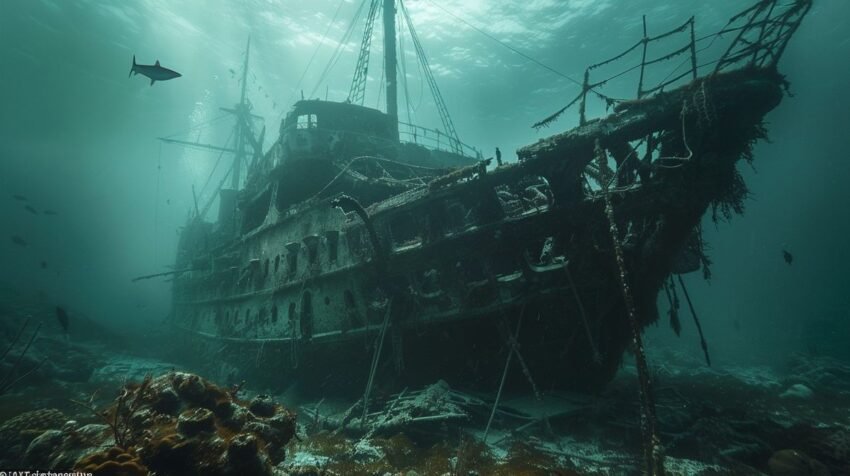Introduction: The Mystery of the Sea
The ocean has always inspired wonder and fear. Beneath its surface lie uncharted depths, while on its vast horizons, sailors have told stories of ghostly apparitions, phantom ships, and mysterious disappearances. These tales, passed down through generations, reflect humanity’s fascination with the unknown. From legends of cursed vessels to real-life maritime mysteries, the sea remains a stage for some of the world’s most chilling stories.
Ghost Ships: Myths or Reality?
A ghost ship is often described as a vessel found adrift, abandoned by its crew under mysterious circumstances. Sometimes these ships appear intact, sails full and cargo untouched, but with no living soul aboard. For centuries, sailors feared encountering such vessels, believing them to be omens of disaster. Whether real or imagined, ghost ships reveal the deep sense of unease that comes from navigating the unpredictable and often unforgiving ocean.
The Legendary Flying Dutchman
Perhaps the most famous ghost ship of all time is the Flying Dutchman. According to legend, this vessel was cursed to sail the seas forever after its captain defied divine forces by attempting to round the Cape of Good Hope during a deadly storm. Sailors across the world have reported sightings of the glowing phantom ship appearing out of mist and vanishing into thin air. The Flying Dutchman became a symbol of bad luck—any sailor who glimpsed it was believed to face impending doom.
The Mary Celeste: History’s Greatest Maritime Mystery
Unlike mythical tales, the Mary Celeste was a real ship discovered drifting in the Atlantic Ocean in 1872. When found, the vessel was seaworthy, its cargo untouched, and provisions sufficient for months—yet the crew was gone. No signs of struggle or piracy were ever uncovered, and theories ranged from mutiny to sea monsters to supernatural curses. To this day, the fate of the Mary Celeste’s crew remains one of the most enduring mysteries of the sea, fueling countless ghost ship legends.
Cursed Vessels and Doomed Voyages
Many ghost ship stories stem from the belief in curses. Sailors often whispered that certain vessels carried bad luck, either due to a violent past, a shipbuilder’s mistake, or a captain’s arrogance. Stories tell of ships that vanished without explanation, only to reappear decades later, drifting aimlessly. These cursed vessels symbolize human fear of fate—an acknowledgment that no matter how advanced our technology, the sea holds powers beyond our control.
Ghostly Crewmen and Phantom Sailors
Not only ships, but sailors themselves are said to return as spirits of the sea. Tales of phantom crewmen who appear suddenly on deck, only to vanish into the mist, have long circulated among mariners. These spectral figures are often described as warning signs of storms, shipwrecks, or death at sea. In many cultures, the souls of drowned sailors are believed to remain forever tied to the waters, guiding or haunting those who follow.
Ancient Legends of Haunted Seas
Long before modern ghost ship tales, ancient civilizations told stories of haunted waters. Greek mythology speaks of Charon, the ferryman who carried souls across the river Styx. Norse legends describe the Naglfar, a ship made from the fingernails of the dead, destined to sail during Ragnarök. In Asian folklore, ghostly ships were believed to carry spirits across oceans to the afterlife. These myths remind us that the sea has always been seen as a bridge between the living and the dead.
Shipwrecks and Spirits
Wherever shipwrecks occur, stories of hauntings follow. Divers exploring sunken vessels often report eerie feelings, strange sounds, or glimpses of ghostly figures. Some believe the souls of sailors lost in shipwrecks linger near their final resting place. Famous wrecks like the Titanic have spawned countless tales of hauntings, with survivors and rescuers reporting visions and unexplained events long after the tragedy. These stories show how human grief and mystery often transform disasters into legends.
The Sea as a Portal Between Worlds
The ocean has always been associated with the unknown, and ghost ship tales often portray the sea as a gateway between worlds. Its vastness and unpredictability make it the perfect setting for stories of spirits caught between life and death. Sailors once believed that fog was a curtain through which ghost ships emerged, and that storms were caused by restless souls. The sea’s mystery makes it easy to imagine it as a place where the supernatural thrives.
Ghost Lights and Supernatural Phenomena
Not all ghostly sightings are ships or crewmen. Sailors often reported strange glowing lights, sometimes called St. Elmo’s Fire, dancing along masts during storms. These natural electrical discharges were often mistaken for supernatural signs. Similarly, phantom lights on the horizon have been linked to atmospheric illusions known as fata morgana. While science explains these occurrences today, to sailors of the past, they were signs of haunted waters and spirits at sea.
Haunted Harbors and Coastal Legends
Not all ghostly tales happen in the open ocean. Many harbors and coastlines have their own haunted reputations. Fishermen have claimed to hear ghostly voices calling their names, while lighthouse keepers often reported spirits walking along the cliffs. In some towns, ghost ships are said to appear offshore as warnings of upcoming storms. These coastal legends reveal how communities living by the sea interpret its dangers through the lens of the supernatural.
Cultural Interpretations of Ghost Ships
Different cultures have their own versions of ghost ship legends. In Japanese folklore, Funayūrei are vengeful spirits of those who died at sea, said to approach sailors and demand buckets of water until ships sink. In Caribbean tales, ghostly pirate ships are believed to haunt certain waters, seeking revenge or treasure. Across Europe, phantom fleets were said to sail at night, representing lost armies or souls of the dead. Though the stories differ, they all reflect humanity’s fear of the sea’s power and mystery.
Modern Sightings and Continuing Mysteries
Even in the modern era, ghost ship tales continue. Reports of abandoned ships drifting into harbors without explanation still surface occasionally. In 2006, a yacht named Kaz II was found off the coast of Australia, abandoned with food set on the table but no crew in sight—echoing the mystery of the Mary Celeste. Such discoveries fuel the belief that the sea still holds secrets beyond human comprehension, keeping ghost ship legends alive in the present day.
The Psychological Side of Sea Legends
Some ghost ship stories may stem from the isolation, exhaustion, and fear sailors faced during long voyages. Weeks at sea without sight of land can create hallucinations, leading to sightings of phantom vessels or crew. Fog, storms, and strange lights only added to the mystery. These psychological experiences, mixed with real maritime tragedies, helped build the vast collection of haunted sea tales we know today.
Why Ghost Ship Tales Endure
Ghost ships and haunted waters remain popular not just because of their mystery but because they symbolize humanity’s relationship with the unknown. The ocean is vast, powerful, and largely unexplored. Every unexplained disappearance or strange occurrence at sea becomes a reminder of how little we truly control. Ghost ship tales endure because they tap into universal fears—loneliness, death, and the supernatural—while also celebrating the storytelling traditions of seafaring cultures.
Conclusion: The Eternal Mystery of Haunted Waters
From the Flying Dutchman to the Mary Celeste, from cursed ships to phantom crews, ghost ship legends reveal the timeless fascination humans have with the sea. Whether these stories are based on real events, psychological illusions, or pure imagination, they continue to capture our minds. The ocean, with its endless horizons and hidden depths, will always inspire tales of mystery. Haunted waters remind us that while technology may advance, the sea will forever keep some of its secrets.


